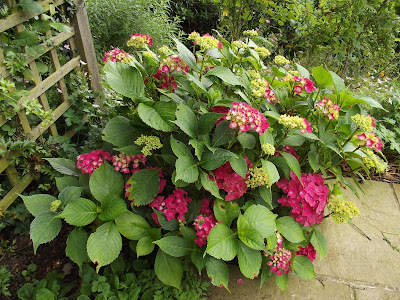I was talking to a neighbour the other day and she was surprised when I said I was fed up with disentangling the bramble runners from the flower bed at the foot of the lawn. I have been pulling and tugging the monsters for several painful years and even investing in a decent pair of leather gloves has not minimised this horrible chore. The aim is always to attack them with the secateurs before they attack me and get as many as I can on the bonfire heap in the shortest possible time. My neighbour was dismayed and thought that since I am (in her eyes) an experienced and competent amateur gardener, I would have the skills and knowledge to deal with the problem permanently.
But a gardening life is not quite like that, is it? It is not straightforward and although I aspire to do things properly, sometimes things get in the way and I have to cut corners. The flower bed we were discussing is very old. It probably took several decades to establish it and several more for it to deteriorate. We garden on a hill and although the bed is 4 feet wide at the front, which is the pretty side, it is actually a steep bank and drops away sharply at the back. The thicket of overgrown shrubs masks the hidden danger of the bank and I have more chance of breaking bones than finding the source of the brambles. Somewhere at the bottom of our list is ‘clear banked bed’ but it would be a major restoration job and several weeks work. We are secretly hoping that we will have been admitted to a nursing home before the task reaches the top of the list.
So, I make the bed look as good as I can under the circumstances. I haul the brambles out twice a year which stops them from reaching the lawn. I hack at the shrubs as neatly as I can and plant attractive plants at the front for colour and to give the impression that all is calm and under control.
‘Making the best of it’ also applies to a lovely pink hydrangea I was given on my 50th birthday. At the time, we had the builders in and the garden was a disaster zone. So I quickly plonked it in a pot and it grew quite well for a couple of years and I even remembered to water and feed it well.
When I discovered it was pot bound, I quickly found it another temporary home, in the border which surrounds the terrace. It was totally the wrong place, being south-west facing, far too dry and sunny in the summer and too windy in the winter. But, seeing as this was only going to be a stop-gap to finding it a permanent position, I was happy.
But of course, it was left longer than I had planned - a few years longer. The move from pot to bed decreased flower production and then we had two dry summers and two really bad winters. Last year I thought I had finally killed it and felt very guilty and sad.
However, this summer it seems to have sensed my sorrow and shame and perked up. When much of the garden has been challenged this summer, this is my hydrangea’s best year for flowering and it has grown quite large. The wet weather must have suited it and it is going to be a mass of pink mop heads contrasted with lush bright green foliage.
It is still technically in the wrong place but I cannot bring myself to move it again, even if it is to a moister, sheltered, semi-shady area of the garden – where it belongs.
I am bemused by the colour-changing quirk of the ‘mop’ hydrangea. Apparently, those with
blue or pink flowers tend to be blue in acid soil conditions and pink in alkaline soil. We have rhododendrons, a camellia and azaleas so we definitely have acid soil. However, our pink hydrangea is definitely pink! I think the soil varies in different parts of the garden.
I quite like to leave the flowers until they have completely faded and have that interesting papery quality and I will leave them there until next spring, to protect the plant from frost during the colder months. Well, that is the plan anyway.

No comments:
Post a Comment